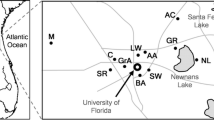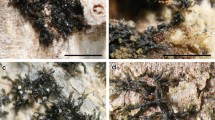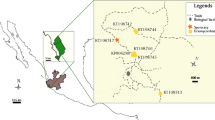Abstract
Fungi in the genus Tomentellopsis were subjected to molecular phylogenetic analyses in order to clarify species-level relationships and mycorrhiza-forming ability with coniferous and deciduous trees. Fungal nucleotide sequence data from the internal transcribed spacer of nuclear ribosomal DNA (ITS rDNA) region were obtained from fruitbodies, ectomycorrhiza and pure cultures. Maximum parsimony (MP), distance (neighbor joining, NJ) and maximum likelihood (ML) analyses of aligned ITS sequences highlighted three clades designated T. echinospora, T. submollis and T. bresadoliana. Sporocarp tissue and ectomycorrhizas, or isolated mycelia, previously described as Pinirhiza rosea, Piceirhiza rosea or Pink were clearly identified in a strongly supported T. submollis clade. Host-linked population variation in this clade was also noted that may reflect active speciation activity. A fungus isolated from Beige-type mycorrhizas formed on Scots pine seedlings appeared in the paraphyletic T. echinospora clade which included sequences showing greater divergence. The data provide a primary classification of Tomentellopsis species that is urgently needed in assessment of the importance of resupinate thelephoroid fungi in mycorrhizal communities associated with trees in coniferous and deciduous forest ecosystems.
Similar content being viewed by others
References
Agerer R (1987–1998) Colour Atlas of Ectomycorrhizae. 1st–11th delivery, Einhorn, Schwäbisch-Gmünd.
Agerer R (1996) Ectomycorrhizae of Tomentella albomarginata (Thelephoraceae) on Scots pine. — Mycorrhiza 6: 1–7.
Agerer R (1998) Tomentellopsis submollis. In Agerer R (ed) Colour Atlas of Ectomycorrhizae, pl. 138. Einhorn, Schwäbisch Gmünd.
Agerer R, Gronbach E (1988) Cenococcum geophilum. In Agerer R (ed) Colour Atlas of Ectomycorrhizae, pl. 11. Einhorn, Schwäbisch Gmünd.
Agerer R, Taylor AFS, Treu R (1998) Effects of acid irrigation and liming on the production of fruit bodies by ectomycorrhizal fungi. — Plant and Soil 199: 83–89.
Anderson IC, Chambers SM, Cairney JWG (1998) Molecular determination of genetic variation in Pisolithus isolates from a defined region in New South Wales, Australia. — New Phytologist 138: 151–162.
Arnolds E (1991) Decline of ectomycorrhizal fungi in Europe. — Agriculture, Ecosystems and Environment 35: 209–244.
Baar J, Horton TR, Kretzer AM, Bruns TD (1999) Mycorrhizal colonisation of Pinus muricata from resistent propagules after a stand replacing wildfire. — New Phytologist 143: 409–418.
Brand F (1991) Ektomykorrhizen an Fagus sylvatica. Charakterisierung und Identifizierung, ökologische Kennzeichnung und unsterile Kultivierung. Libri botanici Vol. 2, pp. 1–228. IHW, Eching.
Brandrud TE (1995) The effects of experimental nitrogen addition on the ectomycorrhizal flora in an oligotrophic spruce forest at Gårdsjön, Sweden. — Forest Ecology and Management 71: 111–122.
Dahlberg A (1991) Ectomycorrhiza in coniferous forests: structure and dynamics of populations and communities. Ph. D. thesis, Swedish University of Agricultural Sciences, Sweden.
Dahlberg A (2001) Community ecology of ectomycorrhizal fungi: an advancing interdiciplinary field. — New Phytologist 150: 555–562.
Danielson RM, Pruden M (1989) The ectomycorrhizal status of urban spruce. — Mycologia 81: 335–341.
Díez J, Anta B, Manjón JL, Honrubia M (2001) Genetic variability of Pisolithus isolates associated with native hosts and exotic eucalyptus in the western Mediterranean region. — New Phytologist 149: 577–588.
Ellis JB (1881) New species of North American Fungi. — Bulletin of the Torrey Botanical Club 8: 64.
Eriksson J, Hjortstam K, Ryvarden L (1981) The Corticiaceae of North Europe. Volume 6. Fungiflora, Oslo. Pp. 1051–1276.
Eriksson T (1998) AutoDecay ver. 4.0 (program distributed by the author). Bergius Foundation, Royal Swedish Academy of Sciences, Stockholm.
Erland S, Taylor AFS (1999) Resupinate ectomycorrhizal fungal genera. In Cairney JWG, Chambers SM (eds) Ectomycorrhizal Fungi: Key Genera in Profile. pp 347–363. Springer, Berlin.
Erland S, Henrion B, Martin F, Glover LA, Alexander IJ (1994) Identification of the ectomycorrhizal basidiomycete Tylospora fibrillosa Donk by RFLP analysis of the PCR-amplified ITS and IGS regions of ribosomal DNA. — New Phytologist 126: 525–532.
Erland S, Finlay RD (1992) Effects of temperature and incubation time on the ability of three ectomycorrhizal fungi to colonize P. sylvestris roots. — Mycological Research 96: 270–272.
Erland S, Söderström B (1990a) Effects of liming on ectomycorrhizal fungi infecting Pinus sylvestris L. I. Mycorrhizal infection in limed humus in the laboratory and isolation of fungi from mycorrhizal roots. — New Phytologist 115: 675–682.
Erland S, Söderström B (1990b) Effects of liming on ectomycorrhizal fungi infecting Pinus sylvestris L. II. Growth rates in pure culture at different pH values compared to growth rates in symbiosis with the host plant. — New Phytologist 115: 683–688.
Fellner R, Pesková, V (1995) Effects of industrial pollutants on ectomycorrhizal relationships in temperate forests. — Canadian Journal of Botany 73(Suppl. 1): 1 S1310–S1315.
Gardes M, White TJ, Fortin JA, Bruns TD, Taylor JW (1991) Identification of indigenous and introduced symbiotic fungi in ectomycorrhizae by amplification of nuclear and mitochondrial ribosomal DNA. — Canadian Journal of Botany 69: 80–190.
Gardes M, Bruns TD (1993) ITS primers with enhanced specificity for basidiomycetes-application to the identification of mycorrhizae and rusts. — Molecular Ecology 2: 113–118.
Hansen L, Knudsen H (1992) Nordic macromycetes, 2, Nordsvamp, Copenhagen
Haug I, Pritsch K (1992) Ectomycorrhizal types of spruce (Picea abies (L.) Karst.) in the Black Forest: A microscopical atlas. Kernforschungszentrum, Karlsruhe.
Heinonsalo J, Jørgensen K, Sen R (2001) Microcosm-based analyses of Scots pine seedling growth, ectomycorrhizal fungal community structure and bacterial carbon utilisation profiles in boreal forest humus and underlying illuvial mineral horizons. FEMS Microbiology Ecology (In press).
Hjortstam K (1970) Studies in the Swedish species of the genus Tomentella (Thelephoraceae). II. — Svensk Botanisk Tidskrift 64: 421–428.
Ilvesniemi H, Giesler R, van Hees P, Magnusson T, Melkerud PE (2000) General description of the sampling techniques and sites investigated in the Fennoscandinavian podzolisation project. — Geoderma 94: 109–123.
Jakucs E, Agerer R (1999) Tomentella pilosa (Burt) Bourdot & Galzin + Populus alba L. — Descriptions of Ectomycorrhizae 4: 135–140.
Jakucs E, Agerer R (2001) Tomentella subtestacea Bourdot & Galzin + Populus alba L. — Descriptions of Ectomycorrhizae 5: 213–219.
Jonsson L, Dahlberg A, Nilsson M-C, Zackrisson O, Kårén O (1999a) Ectomycorrhizal fungal communities in late-successional Swedish boreal forests, and their composition following wildfire. — Molecular Ecology 8: 205–216.
Jonsson L, Dahlberg A, Nilsson M-C, Kårén O, Zackrisson O (1999b) Continuity of ectomycorrhizal fungi in self-regenerating boreal Pinus sylvestris forests studied by comparing mycobiont diversity on seedlings and mature trees. — New Phytologist. 142: 151–162.
Kårén O, Högberg N, Dahlberg A, Jonsson L, Nylund J-E (1997) Inter-and intraspecific variation in the ITS-region of rDNA of ectomycorrhizal fungi in Fennoscandia as detected by endonuclease analysis. — New Phytologist 136: 313–325.
Kõljalg U, Dahlberg A, Taylor AFS, Larsson E, Hallenberg N, Stenlid J, Larsson K-H, Fransson PM, Kåren O, Jonsson L (2000) Diversity and abundance of resupinate thelephoroid fungi as ectomycorrhizal symbionts in Swedish boreal forests. — Molecular Ecology 9: 1985–1996.
Kõljalg U (1996) Tomentella (Basidiomycota) and related genera in temperate Eurasia. Synopsis Fungorum Vol. 9, pp 1–213. Fungiflora, Oslo.
Martin F, Delaruelle C, Ivory M (1998) Genetic variability in intergenic spacers of ribosomal DNA in Pisolithus isolates associated with pine, eucalyptus and Afzelia in lowland Kenyan forests. — New Phytologist 139: 341–352.
Modess O (1941) Zur Kenntnis der Mykorrhizabildner von Kiefer und Fichte. — Symbolae Botanicae Upsaliensis 5: 1–147.
Molina R, Trappe JM, Grubisha LC, Spatafora JW (1999) Rhizopogon. Ectomycorrhizal Fungi: Key Genera in Profile. P. 129–161. Eds. J. W. G. Cairney & S. M. Chambers. Springer-Verlag; Berlin, Germany
Ohenoja E (1993) Effect of weather conditions on the larger fungi at different forest sites in northern Finland in 1976–1988. Ph. D thesis, Universitatis Ouluensis.
Ohenoja E (1988) Effect of forest management procedures on fungal fruit body production in Finland. — Acta Botanica Fennica 136: 81–84.
Pacioni G, Comandini O (1999) Tuber. In: Ectomycorrhizal Fungi: Key Genera in Profile. pp. 163–186. Eds. J. W. G. Cairney & S. M. Chambers. Springer-Verlag; Berlin, Germany.
Sims K, Sen R, Watling R, Jeffries P (1999) Species and population structures of Pisolithus and Scleroderma identified by combined phenotypic and genomic marker analysis. — Mycological Research 103: 449–458.
Smith SE, Read DJ (1997) Mycorrhizal Symbiosis 2nd Edn. Academic Press, London.
Stalpers JA (1993) The Aphyllophoraceous fungi I. Keys to the species of the Thelephorales. Studies in Mycology Vol. 35, pp 1–168. Centraalbureau for Schimmelcultures, Baarn.
Stendell ER, Horton TR, Bruns TD (1999) Short-term effects of a ground fire on the ectomycorrhizal community. — Mycological Research 103: 1353–1359.
Svrček M (1958) Příspěvek k taxonomii resupinátních rodů čeledi Thelephoraceae s. s. — Česká Mykologie 12: 66–77.
Svrček M (1960) Tomentelloideae Čechoslovakiae. — Sydowia 14: 170–245
Tammi H, Timonen S, Sen R (2001) Spatio-temporal colonization of Scots pine roots by introduced and indigenous ectomycorrhizal fungi in forest humus and nursery Sphagnum peat microcosms. — Canadian Journal of Forest Research 145: in press.
Taylor DL, Bruns TD (1999) Community structure of ectomycorrhizal fungi in a Pinus muricata forest: minimal overlap between the mature forest and resistant propagule communities. — Molecular Ecology 8: 1837–1850.
Timonen S, Tammi H, Sen R (1997) Characterization of the host genotype and fungal diversity in Scots pine ectomycorrhiza from natural humus microcosms using isozymes and PCR-RFLP analyses. — New Phytologist 135: 313–325.
Trappe JM (1962) Fungus associated of ectotrophic mycorrhizae. — Botanical Reviews 28: 538–606.
Uhl M (1988) Identifizierung und Charakterisierung von Ektomykorrhizen an Pinus silvestris und von Ektomykorrhizen aus Gattung Tricholoma. Dissertation, Univ. München.
Väre H, Ohenoja E, Ohtonen R (1996) Macrofungi of oligotrophic Scots pine forests in northern Finland. — Karstenia 36: 1–18.
Wakefield EM (1969) Tomentelloideae in the British Isles. — Transactions of the British Mycological Society 53: 161–206.
White TJ, Bruns T, Lee S, Taylor J (1990) Amplification and direct sequencing of fungal ribosomal RNA genes for phylogenetics. In Innis MA, Gelfaud DH, Sninsky JJ, White TJ (eds) PCR protocols. A guide to methods and applications. pp 315–322. Academic Press, San Diego.
Author information
Authors and Affiliations
Corresponding author
Rights and permissions
About this article
Cite this article
Kõljalg, U., Tammi, H., Timonen, S. et al. ITS rDNA sequence-based phylogenetic analysis of Tomentellopsis species from boreal and temperate forests, and the identification of pink-type ectomycorrhizas. Mycol Progress 1, 81–92 (2002). https://doi.org/10.1007/s11557-006-0007-x
Accepted:
Published:
Issue Date:
DOI: https://doi.org/10.1007/s11557-006-0007-x




